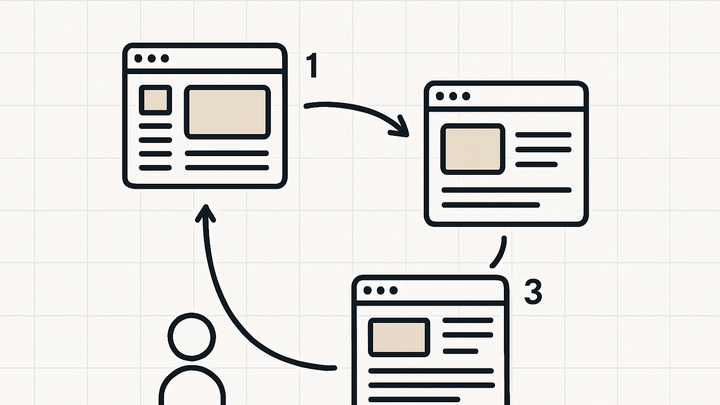Published on 2025-06-22T04:14:15Z
What is Page Depth? Examples with GA4 and PlainSignal
Page Depth is a key engagement metric in web analytics that measures how many pages a user views during a single session. It can refer to the ordinal position of each pageview within a session or an aggregated distribution of sessions by the number of pages viewed. Understanding Page Depth helps you assess user interest, content performance, and navigation efficiency. High page depth often indicates strong engagement, while low depth might highlight areas where visitors lose interest or encounter barriers. By monitoring this metric, analysts can optimize site structure, improve internal linking, and enhance overall user experience.
Page Depth differs from related metrics like pageviews and sessions by focusing on the sequence and depth of user exploration rather than total visits or session counts. Advanced tools like Google Analytics 4 (GA4) and privacy-focused solutions like PlainSignal can track Page Depth with minimal configuration, providing insights without reliance on cookies. Whether you aim to boost conversions, refine content strategy, or streamline navigation paths, Page Depth offers a clear lens into how deeply visitors engage with your website.
Page depth
Page Depth measures how many pages a visitor views per session, revealing engagement depth and navigation patterns.
Why Page Depth Matters
Page Depth uncovers how deeply visitors explore your website, guiding decisions on content placement and site structure.
-
User engagement indicator
High page depth usually signals that visitors find your content compelling and continue to explore multiple pages, indicating deeper engagement.
-
Content performance insights
Analyzing which page depths drive conversions or interactions helps you optimize content flow and internal linking strategies.
-
Navigation efficiency
Page depth patterns can reveal navigation bottlenecks or orphan pages where users drop off early, guiding UX improvements.
How Page Depth is Calculated
Metrics for Page Depth can focus on individual pageviews within a session or aggregate sessions by their total page counts. Here’s how it’s typically defined:
-
Ordinal pageview position
Each pageview in a session receives a sequential number: 1 for the first pageview, 2 for the second, and so on.
-
Formula
Page Depth = Position of a pageview within its session (Pageview Index).
-
-
Maximum page depth per session
The highest number of pages viewed in a single session, representing peak user engagement within one visit.
-
Session depth distribution
Buckets sessions based on page count (e.g., sessions with 1 page, 2–3 pages, 4+ pages) to show the distribution of engagement levels.
Tools for Tracking Page Depth
Page Depth can be tracked with various analytics platforms. Below are examples using Google Analytics 4 and PlainSignal.
-
GA4 implementation
Google Analytics 4 automatically collects page_view events. Add this snippet to deploy GA4 and then analyze Page Depth in the Explorations report:
<script async src='https://www.googletagmanager.com/gtag/js?id=G-XXXXXXXXXX'></script> <script> window.dataLayer = window.dataLayer || []; function gtag(){dataLayer.push(arguments);} gtag('js', new Date()); gtag('config', 'G-XXXXXXXXXX', { 'send_page_view': true }); </script>In GA4, go to Explorations → Free form, add the “Page depth” metric under Engagement, and view the distribution.
-
PlainSignal (cookie-free) implementation
PlainSignal provides a privacy-friendly way to track pageviews and session depth without cookies. Include this code in your HTML:
<link rel='preconnect' href='//eu.plainsignal.com/' crossorigin /> <script defer data-do='yourwebsitedomain.com' data-id='0GQV1xmtzQQ' data-api='//eu.plainsignal.com' src='//cdn.plainsignal.com/plainsignal-min.js'></script>PlainSignal will capture pageview events and session identifiers automatically. Use the ‘Page depth’ filter in the PlainSignal dashboard to visualize engagement.
Best Practices and Considerations
To ensure accurate and actionable Page Depth analysis, consider the following best practices and potential pitfalls.
-
Filter bot and spam traffic
Exclude known bots to prevent artificial inflation of page depth metrics from non-human visits.
-
Session timeout configuration
Adjust session timeout settings to reflect realistic user behavior. Too short timeouts can split long visits, underreporting depth.
-
Consider single-page applications
For SPAs, implement virtual pageviews or custom events to capture content updates and maintain accurate page depth counts.
-
Complement with other metrics
Use Page Depth alongside Time on Page, Scroll Depth, and Conversion Rate to get a holistic view of user engagement.
